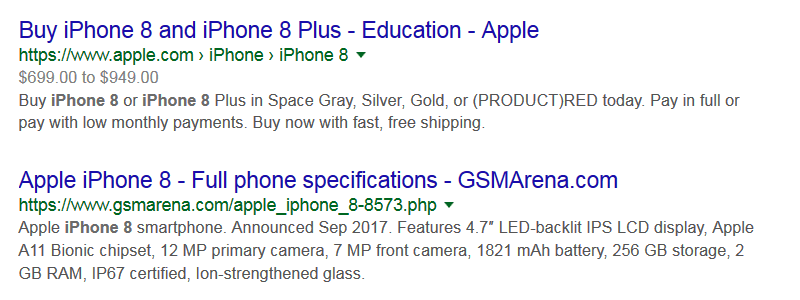
Optimizing your meta descriptions is an important aspect of on-page SEO.
Unfortunately, because meta descriptions are not a direct ranking signal, some SEO professionals fail to give them the attention they deserve.
Little do they know that properly optimized meta descriptions play an important role in getting visitors from search engines to click your links. They are mini-ads that you can optimize to drive more customer action and increase CTR.
If you are ready to spend some time enhancing your meta descriptions, first be aware of these six common meta description optimization mistakes.
Mistake 1: Duplicate Meta Descriptions
Even though meta description duplicates won’t get you penalized, you should put together unique meta descriptions for every page for practical reasons.According to Google:
Good meta descriptions are short blurbs that describe accurately the content of the page. They are like a pitch that convinces the user that the page is exactly what they’re looking for.Since meta descriptions act as “a pitch” in the SERPs, you can use them to control the narrative around your site. The better you deliver your message with unique copy, the better chance you have of driving more traffic to your pages and increasing CTR.
If all of your pages have similar meta descriptions, they will be more misleading than helpful.
If you don’t have time to write meta descriptions for every page, you can let Google generate them automatically. Based on the query, Google will pull relevant parts of your page’s content to feature in the snippet.
Bear in mind that it is still preferable to have unique meta descriptions for your core pages, such as your homepage, category pages, and top-performing pages with content, products, or services.
As a shortcut, you can also use a template to automatically generate meta descriptions for more or less similar pages. Change one single keyword and get OK-ish meta descriptions.

Mistake 2: Character Count Obsession
For many years, the SEO best practice was to write a meta description between 135–160 characters.That changed in 2017, however. Google meta descriptions can now be as long as 320 characters.
In the screenshot below, the first meta description is 161 characters long. The second one is 240 characters long, and it does not get truncated.

However, when it comes to Google’s longer search snippets, it’s really pixels, not characters, that actually matter.
Based on the width of the device, your ideal meta description can be between 160 and 320 characters long (920 -1,840 pixels). That is why, if you have short descriptions, you should not necessarily try to squeeze more characters in.
On top of that, bear in mind that Google does not always display manually assigned meta descriptions. When the situation calls for it, it generates unique, longer descriptions by simply pulling a relevant piece of content from a page.
In other words, don’t waste time obsessing about the ideal number of characters in your meta descriptions.
Mistake 3: Not Using Keywords
Your meta descriptions should include the right keywords. You want to use keywords that:- Are relevant to a page’s content.
- Your customers are looking for.
For instance, when I was searching for productivity tips, I found this description:

Google pulled the first sentence with the keyword “productivity” in it. No wonder, since the page’s meta description is: “From Eric Schmidt to Danny Meyer: How super successful, super busy entrepreneurs organize their day.”
Though this meta description is creative, it looks and feels like a title. Plus, it does not feature any keywords related to either “productivity” or “tips.”
In short, ensure that your meta descriptions are aligned to a page’s title and are relevant to the page’s content. Otherwise, you can end up with irrelevant truncated descriptions pulled out of context.
Mistake 4: Not Optimizing for Rich Snippets
Structured data optimization should be on your to-do list.With rich snippets, your meta descriptions will easily stand out in the crowd.
Just look at this example:

There are many schema types you can use to optimize your pages, but the most common are:
- Review
- Aggregate Review
- Product
- Offer
- Place
- Local Business
- Person
- Event
- Creative Work
If you are unsure how to start, Google guidelines will help. Plus, you can use lots of tools, like:
In short, rich snippets can make a difference in terms of the quality of your meta descriptions. Make sure to optimize for them.
Mistake 5: Avoiding HTML Tables for Direct Answer Queries
Since Google’s mission is “To organize the world’s information and make it universally accessible and useful,” the search engine naturally gives preference to websites that provide direct answers to searchers.In this context, HTML tables can help you gain an upper hand over your competition. Just compare two search results for “samsung galaxy s8 plus specs” below:
 Without HTML table
Without HTML table With HTML table
With HTML tableThis table-based result gives a direct answer, and is convenient for searchers. No wonder Google places it at the top of search results, even above the dedicated Samsung Galaxy S8 Plus page by Samsung.com.
With that said, identify question-based search queries, prepare detailed answers, implement HTML with structured data, and enjoy high positions in the SERPs for direct answer queries.
All you need is to learn some HTML table basics and be pretty good at structured data markup. This HTML Tables as Google Rich Snippets guide will help.
Mistake 6: Writing Boring, Unimpressive Copy
Does this meta description sound familiar?
A wide selection. Free shipping. Free returns. Eligible items…
Amazon, you can do better!
Boring and unimpressive copy in meta descriptions is so common that most users do not even notice them. However, creative copy that plays up to your user’s expectations will not only help you stand out in the crowd, but will also increase traffic, CTR, and conversions.
Here are five simple rules you can rely on to improve the copy of your meta descriptions:
1. Keep Your Copy Readable
Avoid keyword stuffing at any cost. Meta descriptions are not a ranking factor, and you do not want to give visitors the impression that your website is spammy.Your meta descriptions should feel and look natural.

While the description above offers productivity tips right in the snippet, the text does not look normal and human-written.
Ensure that your meta descriptions consist of logically-bound sentences, not parts of text pulled out of context.
2. Make Your Copy Specific
Vague copy that does not tell much to users is a no-no.Make sure that your meta descriptions include all details and specifics that match the content on the page.

The example above not only provides enough details, but also makes customers curious, which is never a bad thing.
3. Use Numbers, Symbols & Special Characters
Headlines with numbers generate 73 percent more social shares and engagement. Using numbers in meta descriptions makes sense as well.Actually, not only numbers, but any characters other than letters (e.g. symbols, special characters, emojis, etc.) can help drive customers to your web pages.

4. Keep Your Copy Customer-Centric
The first two questions your customers ask when coming across any search result are, “What is this page offering?” and “Why should I visit this page?”.Naturally, your meta descriptions should answer these questions. They should appeal to your customers, talk about your customers, and solve your customers’ problems.
Your meta descriptions should not be about you or your business. Do not write meta descriptions like the one below:

5. Include a CTA
This one is optional. In some cases, CTAs can feel too aggressive and even “screamy.”
However, a clear, respectful CTA provides guidance to your customers.

Conclusion
High-quality meta descriptions can make a difference for your website. Though they do not impact your site’s organic search rankings directly, meta descriptions can help your business stand out in search results.Put together value-packed, optimized meta descriptions that match the content on your site’s pages and reap the benefits. Avoid making the mistakes outlined in this article, and you will get higher CTRs, drive more targeted traffic, and improve conversions.
Reference:https://www.searchenginejournal.com/meta-description-mistakes/250897/?ver=250897X3
No comments:
Post a Comment